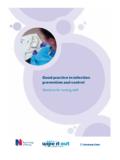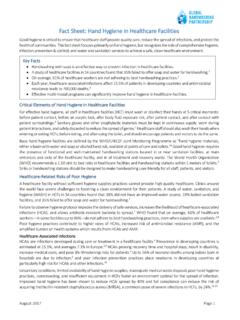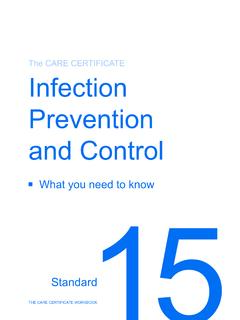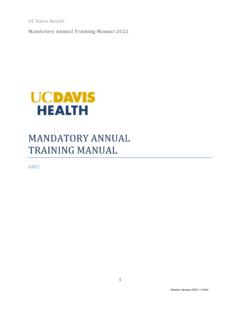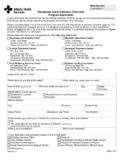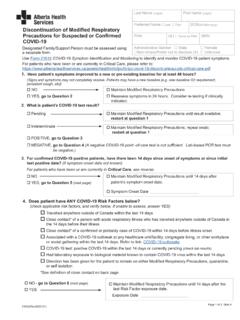Transcription of AN INFECTION CONTROL MODULE: STANDARD …
1 AN INFECTION CONTROL MODULE: STANDARD PRECAUTIONS We hope you enjoy this inservice, prepared by registered nurses especially for caregiver like you! After finishing this inservice, you will be able to: Describe STANDARD precautions and discuss why they are so important in the healthcare setting. List at least five of the Top Ten STANDARD precaution guidelines. Discuss the difference between STANDARD precautions and transmission-based precautions. Explain how healthcare workers can break the chain of INFECTION . Demonstrate proper INFECTION CONTROL precautions in your daily work. If you are studying the inservice on your own, please do the following: Read through all the material. You may find it useful to have a highlighting marker nearby as you read.
2 Highlight any information that is new to you or that you feel is especially important. If you have questions about anything you read, please ask your supervisor. Take the quiz. Think about each statement and pick the best answer. Check with your supervisor for the right answers. You need 8 correct to pass! Print your name, write in the date, and then sign your name. Email In the Know at with your comments and/or suggestions for improving this inservice. THANK YOU! Instructions for the Learner An INFECTION CONTROL Module: STANDARD PRECAUTIONS An INFECTION CONTROL Module: STANDARD Precautions WILL YOU DO THE RIGHT THING? Inside This Inservice: The Chain of INFECTION 2 Precautions Overview 3 STANDARD Precautions Top Ten 4 Contact Precautions 5 Airborne Precautions 6 Droplet Precautions 7 The Facts About Handwashing 8 Handling Client Care Equipment 9 Handling Biohazardous Waste 10 STANDARD PRECAUTIONS are basic INFECTION CONTROL guidelines for you to follow as you perform your daily work.
3 STANDARD Precautions include: Washing your hands. Using protective equipment like gloves, gowns, and masks. Handling infectious waste material properly. STANDARD Precautions are written and regulated by OSHA (the Occupational Safety and Health Administration). It is important to remember that OSHA regulations are federal law. This makes following STANDARD Precautions guidelines mandatory within all healthcare facilities. Unfortunately, no one is going to follow after you and remind you to wash your hands or put on a gown and gloves before handling bodily fluids. It s completely up to you to DO THE RIGHT THING and follow STANDARD precautions to protect yourself and others from INFECTION . You work in a germ factory! Your clients, their environment, and even your co-workers carry, grow and spread germs everywhere.
4 Some of these germs can be serious. And, some can even be deadly. Because you spend so much time in the germ factory, your chances of being exposed are pretty good. You might pick up a germ by touching it, breathing it, or by having a droplet land on the mucus membrane in your nose or eye. Once you've been exposed, you may become infected. That's when you actually get sick from the germ. Or, you may never get sick, but unknowingly pass the germ on to someone else who will get sick. This cycle is known as the chain of INFECTION . It's a pretty tough cycle to break. But, the good news is .. there is a proven method to keep yourself and others safe. It's called STANDARD Precautions. 2020 In the Know Expires 12/31/2022 IMPORTANT: This topic may be copied for use within each physical location that purchases this inservice from In the Know.
5 All other copying or distribution is strictly prohibited, including sharing between multiple locations and/or uploading the file or any portion thereof to the internet or to an LMS (unless a license to do so is obtained from In the Know). In accordance with industry standards , this inservice material expires on December 31, 2022. After that date, you may purchase a current copy of the materials by calling 877-809-5515. THE CHAIN OF INFECTION An INFECTION CONTROL Module: STANDARD Precautions 2020 In the Know Expires 12/31/2022 Page 2 Grab your favorite highlighter! As you read through this inservice, highlight five things you learn that you didn t know before. Share this new information with your supervisor and co-workers! 1. INFECTIOUS AGENT: This is any organism with the ability to cause disease.
6 It may be a virus, bacteria, fungus, or a parasite. 2. RESERVOIR: This is any place where the infectious agent is happy to live and grow! The best reservoirs are people, like your clients and co-workers plus certain places in the environment, like tables doorknobs, and bathrooms. 3. MODE OF TRANSMISSION: This is the way the organism gets from one place to another. In the healthcare setting this is almost always YOU! The most common mode of transmission in healthcare settings is by the hands of healthcare workers. 4. SUSCEPTIBLE PERSON: This is any person who cannot block germs from invading the body, or from multiplying and causing an INFECTION . Most of your clients are considered susceptible people. Clean, clean, and clean some more! Disinfect surfaces and equipment to destroy infectious agents. Without an infectious agent, there is no Chain of INFECTION !
7 Apply STANDARD precautions to everyone. And, identify, isolate, and use transmission-based precautions with people who have known infections. Wash your hands before and after any contact with clients and their environments! Will YOU break the chain? 2020 In the Know Expires 12/31/2022 Page 3 An INFECTION CONTROL Module: STANDARD Precautions STANDARD PRECAUTIONS: STANDARD precautions are the common sense INFECTION CONTROL guidelines you should follow as you perform your daily tasks with clients. (See detailed the TOP TEN guidelines on page 4.) STANDARD Precautions apply to all your clients, no matter what their diagnosis even if they don t seem sick! STANDARD Precautions means you assume all blood, body fluids, secretions, open wounds, and mucous membranes contain an INFECTION , and use: Gloves As needed, to protect hands your hands.
8 Gowns As needed, to protect your skin and clothing. Masks As needed, to protect you mouth and nose. RESPIRATORY HYGIENE AND COUGH ETIQUETTE: This is a fairly new recommendation from the CDC that applies to everyone with a cough or cold symptoms, especially those with fever. It requires that everyone cover their noses and mouths with a tissue or the inside of the elbow when coughing or sneezing, dispose of tissues properly, and perform frequent hand washing. TRANSMISSION-BASED PRECAUTIONS: These are the guidelines used when a client has a highly contagious INFECTION . Transmission-based precautions include: (See detailed descriptions of transmission precautions on pgs. 5-7.) LOOK HOW FAR WE VE COME! In the 1830s, most people believed that sunlight and fresh air killed germs. Up until the mid-1800s, surgeons rarely washed their hands or a patient's skin before surgery.
9 Surgical instruments were only rinsed and sponges were reused. In 1860, Joseph Lister began to spray carbolic acid on surgical wounds, instruments, and dressings. This reduced the number of deaths from surgery. Gloves were first used in the early 1900s to protect nurses' hands from chemicals used during surgery. Years later, gloves became a barrier, protecting patients and healthcare workers from INFECTION . Until 50 years ago, patients with all different kinds of diseases stayed in the same room or ward. In another hundred years, people will look back at the way things are done today. What do you think they will consider absurd or crazy about the way we did things in the 2000 s? What changes do you think will happen in this century to improve INFECTION CONTROL ? OVERVIEW OF PRECAUTIONS PRECAUTION WHAT EQUIPMENT IS NEEDED?
10 WHEN IS THIS USED? Contact Precautions Gloves and gown must be worn for all contact with the client and the client s environment. MRSA, VRE, e-coli, pink eye and hepatitis A. Droplet Precautions A mask must be worn for all contact within three feet of the client. Pertussis, flu, strep throat, mumps, and rubella. Airborne Precautions A mask must be worn when ever you are in the same room as the client. Measles, chickenpox, and shingles. Expanded Airborne Precautions A fit tested respirator must be worn for all contact with the client. Tuberculosis (TB), smallpox and SARS 2020 In the Know Expires 12/31/2022 Page 4 An INFECTION CONTROL Module: STANDARD Precautions #1. WASH YOUR HANDS! Wash your hands before and after any contact with the client or the client s environment. In addition, you must wash your hands before putting on gloves and after taking them off.
